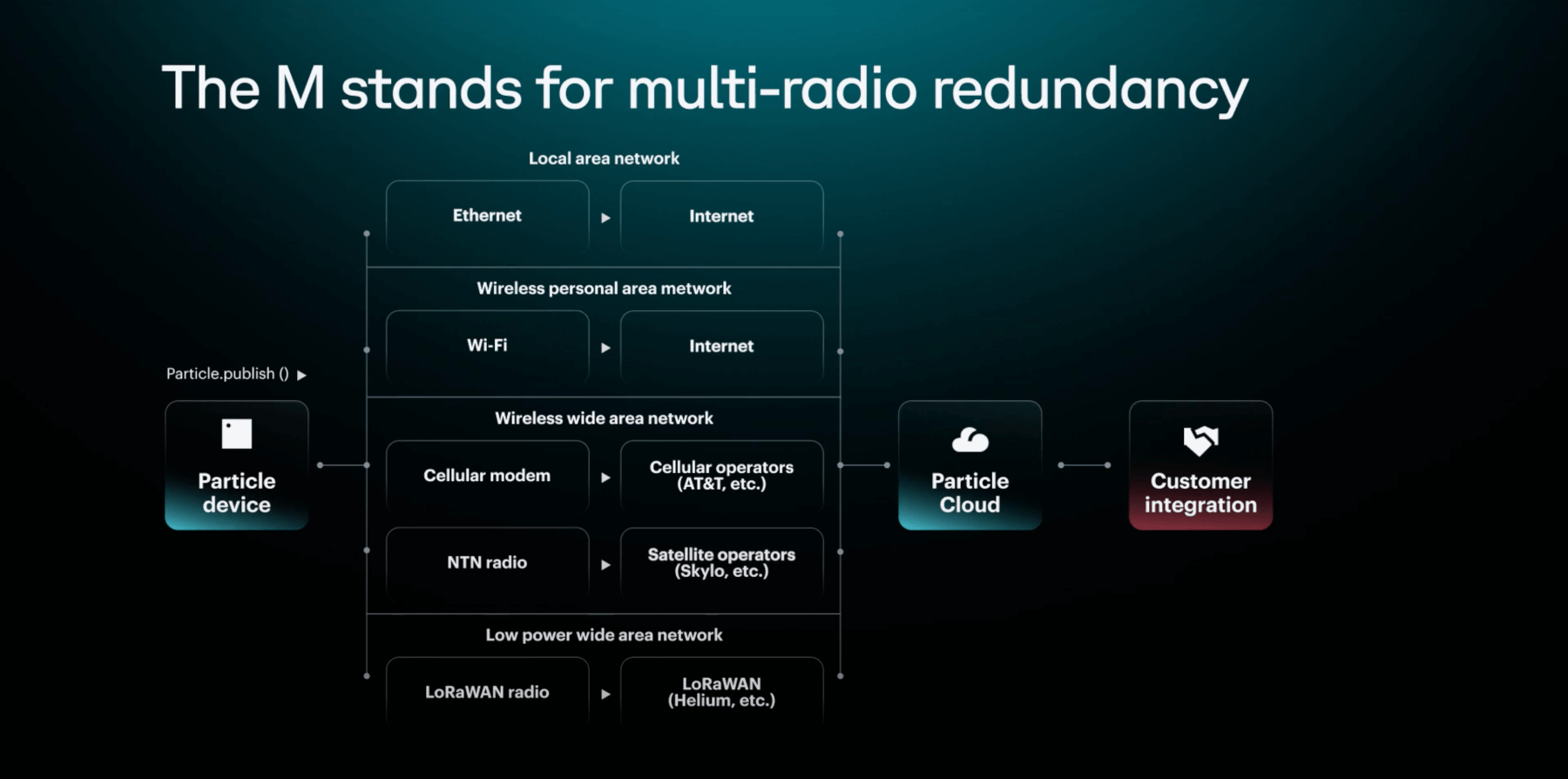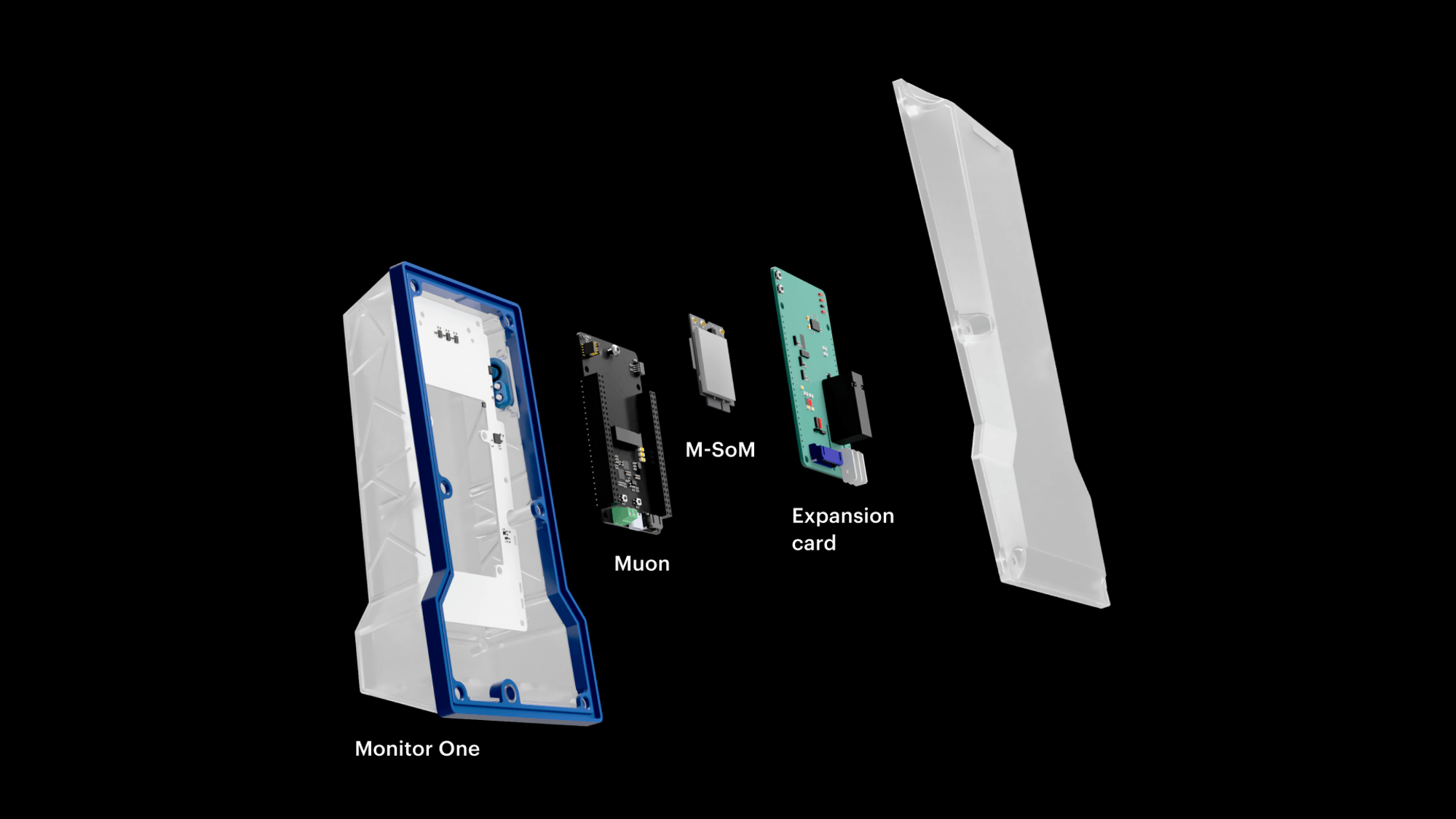Continuous connectivity with multi-radio enablement
Explore how multi-radio technology ensures continuous, reliable IoT connectivity in diverse environments.
Ready to build your IoT product?
Create your Particle account and get access to:
- Discounted IoT devices
- Device management console
- Developer guides and resources
Continuous connectivity is fundamental for reliable data transmission, real-time monitoring, and efficient system operations. As IoT devices are deployed in diverse environments, they face challenges in maintaining stable connections due to the limitations of individual wireless technologies. This article explores continuous connectivity, the concept of multi-radio technology, and how it addresses the challenges of seamless and expansive IoT communication.
The need for continuous connectivity
IoT devices rely on wireless communication protocols to transmit data and interact with other devices or systems. However, each wireless technology has its strengths and weaknesses regarding range, bandwidth, power consumption, and environmental suitability. For instance, Wi-Fi provides high bandwidth but limited range, while cellular networks offer wider coverage but may not penetrate deep into buildings or underground facilities. Satellite communication can provide global coverage but suffers from high latency and limited indoor penetration.
To ensure reliable IoT communication, devices must maintain a stable connection even when the primary wireless network becomes unavailable or experiences degraded performance. This is where multi-radio technology comes into play.
Multi-radio technology
Multi-radio technology equips IoT devices with multiple wireless modules, each supporting a different communication protocol. These modules can include:
- Wi-Fi (802.11): Provides high-bandwidth, short-range connectivity for indoor environments.
- Cellular (LTE Cat-M1/NB-IoT, Cat 1): Enables wide-area coverage using existing cellular networks, suitable for outdoor and mobile applications.
- LoRaWAN: A low-power, long-range protocol connecting battery-operated devices in large-scale deployments.
- Satellite (NTN): Offers global coverage using non-terrestrial networks, ideal for remote and inaccessible locations.
By incorporating multiple wireless modules, IoT devices can dynamically switch between networks based on availability, signal strength, and application requirements. This multi-radio approach ensures continuous connectivity by leveraging each wireless technology's strengths and mitigating its limitations.

Failover and load balancing
One key advantage of multi-radio technology is its ability to continuously monitor the availability and quality of each wireless connection. If the primary network becomes unreachable or experiences degraded performance, the device should automatically switch to the next available network based on predefined priorities.
This failover mechanism ensures uninterrupted data transmission and minimizes downtime. Additionally, load balancing allows the device to distribute data traffic across multiple networks, optimizing bandwidth utilization and reducing congestion.
Security considerations
Implementing multi-radio technology introduces new security challenges, as each wireless network has its own security mechanisms and potential vulnerabilities. To ensure end-to-end security, multi-radio connectivity IoT devices should utilize a combination of hardware-based security features and software-defined security protocols.
Hardware: Secure elements (SEs) can be integrated into a device's system-on-chip (SoC) or microcontroller unit (MCU) at the hardware level. SEs are specialized microprocessors designed to store sensitive data and run secure applications. Their tamper-resistant nature provides an additional layer of protection against malware attacks. By offering hardware-based encryption and secure key storage, SEs enhance the device's resilience against tampering and unauthorized access attempts.
Software: IoT platforms should implement secure device provisioning, authentication, and data encryption using industry-standard protocols. Transport Layer Security (TLS) and its variant, Datagram Transport Layer Security (DTLS), are widely used to establish secure communication channels between IoT devices and cloud platforms. These protocols ensure that data transmitted over the various wireless networks remains confidential and integrity-protected.
Practical applications of multi-radio connectivity for IoT
The continuous connectivity enabled by multi-radio technology is crucial for a wide range of IoT applications. Notable examples include:
- Remote asset tracking: Multi-radio IoT devices can monitor the location and status of valuable assets, such as vehicles, equipment, or shipping containers, across different environments to provide real-time visibility and insights.
- Environmental monitoring: IoT sensors equipped with multi-radio capabilities can be deployed in remote locations, such as forests, oceans, or glaciers, to collect data for studying climate change, ecological patterns, or natural resource management.
- Industrial automation: In manufacturing plants and supply chain operations, uninterrupted communication between machines, sensors, and control systems is essential for optimizing processes, reducing downtime, and enhancing overall efficiency.
- Smart city infrastructure: Smart cities rely on a vast network of connected devices, such as traffic sensors, public safety systems, smart meters, and environmental monitoring stations. With multi-radio technology, these devices can enable efficient management of city resources and services.
As the IoT landscape continues to evolve, the applications of multi-radio technology will expand. The ability to maintain continuous connectivity, regardless of the environment or network conditions, will be a crucial enabler for the growth and success of IoT solutions in the future.
Seamless integration with IoT platforms
When building a product that requires constant IoT connectivity, seamless multi-radio connectivity should be a top consideration. This is particularly important for applications that rely on uninterrupted data flow, such as real-time monitoring or mission-critical control systems. Opting for a product ecosystem like Particle, which offers a unified platform for managing and orchestrating communication across diverse networks, will streamline the development process and provide a solid foundation for your IoT product's success.
The Particle platform abstracts the complexity of multi-radio communication, allowing developers to focus on building applications rather than dealing with low-level network protocols. Through a single API, developers can send and receive data from devices, regardless of the underlying wireless technology.

The Particle M-Series and continuous connectivity
Particle's recently developed M-Series devices address the challenges of seamless IoT communication by leveraging the strengths of multiple wireless technologies.
By combining Wi-Fi, cellular (LTE Cat-M1/NB-IoT and Cat 1), LoRaWAN, and satellite NTN connectivity, M-Series devices can maintain stable and secure connections in diverse environments, providing failover and load balancing capabilities while seamlessly integrating with the Particle platform.
The M-Series portfolio consists of:
- M-SoM (System-on-Module): A compact module that integrates the main processor, memory, and wireless modules.
- Muon: A development board that houses the M-SoM and provides additional features such as expansion ports and power management.
- Monitor M: An industrial gateway accommodating the Muon and offering an enclosure for field deployments.

As wireless technologies advance, the future of IoT communication looks promising, with the potential for ubiquitous, high-performance, and secure Internet of Things connectivity. Adopting multi-radio technology will pave the way for new IoT applications and drive innovation across various industries, from smart cities and industrial automation to remote monitoring and global asset tracking